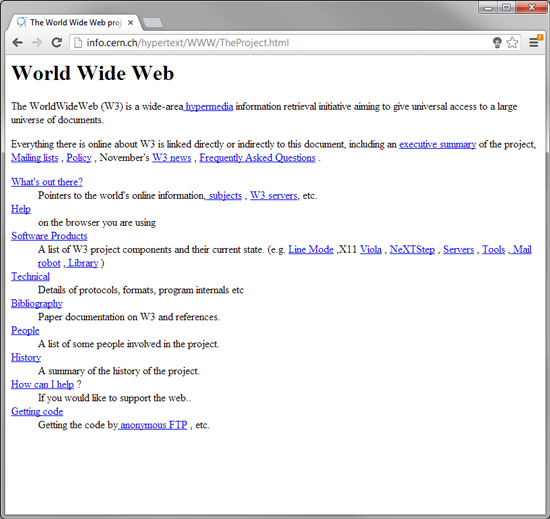|
Last week, the Word Wide Web officially turned 20 years old.
Back on April 30, 1993, CERN issued a statement saying that the World Wide Web was now officially in the public domain. (It wasn’t Al Gore.)
The World Wide Web (that’s why you type in "www" before a domain name to visit a site) was invented by Tim Berners-Lee in 1989 on a NeXT computer. The NeXT computer was invented by Steve Jobs, after he was kicked out of Apple. But that’s another story.
Why was the Web created? Back in 1989, Tim Berners-Lee saw a problem: it was really difficult to share documents with other researchers. There were many different types of computer systems (many more than today), and files were often incompatible. Sharing was difficult.
The World Wide Web project was "based on the philosophy that much academic information should be freely available to anyone."
Berners-Lee came up with a way that someone could post a page on a Web server, and easily link to other pages on that site, or to pages on another site. He invented HTML (hyper text markup language) to display information, including text and links. He put together the www protocol, and lots of other technical information, including the first Web server.
CERN recently re-built the very first website on the Web: You can view it here >>
 The First Website ever. Not much in the way of flashy graphics, but all modern Websites still use this basic structure. The First Website ever. Not much in the way of flashy graphics, but all modern Websites still use this basic structure.
In 1993, I was an intern at the White House, and like all good interns, I helped read and answer the mail. At the time, we were talking about the Information Superhighway, which would allow job seekers to go to a public library and connect with employers.
I was already into computers and technology. I purchased a 300 baud modem for my Apple IIe, and convinced my parents we needed a second phone line so I could dial into bulletin boards (this was pre-AOL). Text literally scrolled character-by-character across the screen.
How the world has changed since then:
- These days, my eight-year-old daughter finds out the weather by talking to her iPod touch.
- We control the heat and air conditioning of our home and office through an app on my iPad and iPhone. Temperature too hot in the middle of the night? No need to get out of bed.
- I’ve always been a news junkie, and can read the news from around the world on an iPad.
- I interact with friends around the world via Facebook, Google+, LinkedIn, Twitter, Instagram and more.
- Gone are the days of film. I can take photographs in the Middle East, and upload them while I’m still away.
- My entire company, Customer Paradigm, is focused on helping businesses and organizations acquire, retain and interact with people via the Web, and employs 25 people.
- Most of those employees we’ve found via Craigslist or other web-based means as well.
Six percent of retail purchases in the US are now made online. In the UK, it’s now 12%.
In the next few years, you’ll see:
- Same day shipping on products from eCommerce websites, further eroding your desire to drive across town to pick something up now.
- Mobile, Mobile, Mobile. Desktop and laptop purchases are in decline; tablets and smart phones are what people want to buy now.
- More devices than people connected to the Web. You can already purchase light bulbs for your home that you can control from a mobile device as far as turning them on and off, setting them up on schedules and even changing their colors.
… and lots of things that are now in the realm of science fiction, that will become reality soon.
For example, the computer from Star Trek? Google is actually working on making that a reality. Same thing with self-driving cars.
Until next week,

Jeff Finkelstein
Founder, Customer Paradigm
303.473.4400
Connect
Via Facebook >>
Connect
Via Google+ >>
Connect
Via Linked In >>
Connect
Via Twitter >>
We
love referrals! Our
Referral Promise >>
|